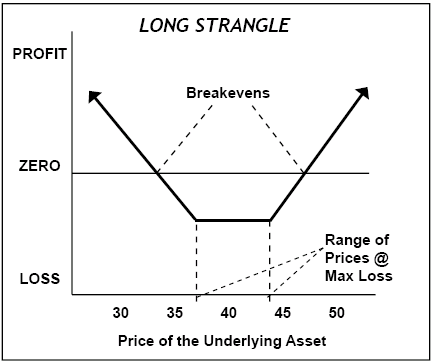Option Strangles
Traders who strongly believe the price of an underlying asset will change significantly in the near future but are unsure about the direction of the move can trade combinations of options that differ only in the exercise price. A common combination strangles. These are option trading strategies that combine both puts and calls to create positions that do not depend on the direction of the market movement for their profitability. Long strangles make money if the stock price moves up or down significantly.
A long strangle is long one call at a higher strike and long one put at a lower strike in the same expiration and on the same stock. Such a position makes money if the stock price moves up or down well past the strike prices of the strangle. There are higher costs and risks with these strategies, as I discuss below.
- Strangles are low risk plays, one side of the options will go up in value when the other side goes down in value the majority of the time.
- If one side becomes worthless it generally means the other side is worth a lot.
- You can make money on strangles even when you do not know which way the market will move.
- It is much less stressful to hold a position with a hedge in place.
- The big risks are transferred from the option buyer to the option seller in this play.
- Strangles lose small with small movements but win big when there is a big move. The are asymmetrical in their construction.
- When one side of the option sellers blow up their account due to an outsized move you will be on the other side of them and be the trader their capital flows to.
- Strangles can be played on any time frame.
- With the strangles the winning side has a growing delta and the losing side has a shrinking delta.
- Strangles can be used to capture trends, volatility, and reversals.
Where is the risk?
- Time is against the strangle play, theta value is being lost as you wait for the move to take place.
- You have bigger liquidity risk with options than with stocks, only play options with tight bid ask spreads. It costs money to get in and out of these trades buying the ask and selling the bid.
- Strangles can go down in value if implied volatility decreases and is priced out.
- When they become profitable they become directional and you have to exit properly to keep those profits.
- Commission costs are generally more expensive with options than stocks. Be aware of how much it costs with different numbers of contracts and how that will effect your P&L.
